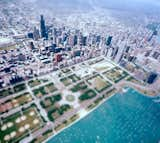
Obama as an Experiment in Urban Form
Of course, it's not all trouble-free walksheds and sustainable urban design in south Chicago, simply because of the Obama's choice of residence. As an article in the Chicago Defender pointed out, "beefed up security measures around [Obama's] South Side home have changed the lives of neighbors"—in many ways, not for the better.
For instance, a local resident named Nelson Barrington spoke to the Defender about the often-negative changes he's witnessed since the election: "If you live in Hyde Park, you are used to parking restrictions but not used to having your visitors screened prior to being allowed entrance into the neighborhood. I don’t know too many women who will want to come visit me if they have to have their purse inspected upon arrival."
"Hey, he’s the man now," Barrington continues, "so it wouldn’t be a bad idea to move his family to a safer environment. I’m sure that would make the Secret Service happy. I can only imagine how difficult it is to protect him in such an urban community where everything is built so close to each other."
My point here is not to dwell on the bad side—the very real neighborly inconveniences—of Obama being an urban president; I want only to speculate briefly as to whether or not these security measures might offer an unlikely glimpse of how our cities could be reorganized.
Perhaps, in this moment of urban redesign demanded by presidential necessity, we might find that pedestrianization is something we all can happily live with. Obama's neighborhood thus becomes something like an experiential design lab for new ways of running the city.
So if green design advocacy groups, environmentalists, and even Dwell editors have suggested, sometimes repeatedly, that our cities need to prioritize non-automotive traffic, from pedestrian plazas to bike routes, then Obama's presidency might give us something else to hope for. Because if a small section of Chicago's Hyde Park is going at least partially car-free, and if this experiment ultimately proves not to be as disruptive as once thought, then at least one part of Obama's urban legacy might already have begun.
[I'm indebted to Chicago-based architect Doug Garofalo for first mentioning the ironically sustainable security measures being enacted in Obama's Hyde Park. Opening tilt-shift aerial photograph of Chicago taken by Michael Baird.]
Published
Last Updated
Get the Dwell Newsletter
Be the first to see our latest home tours, design news, and more.